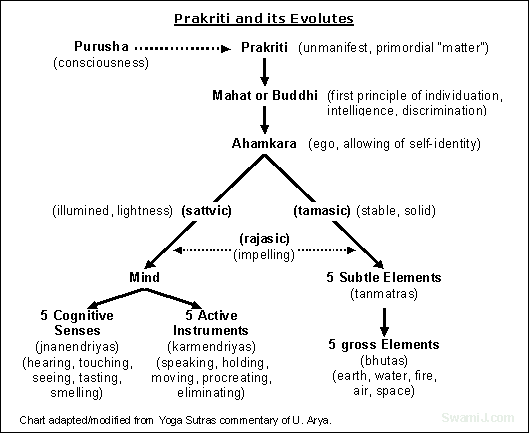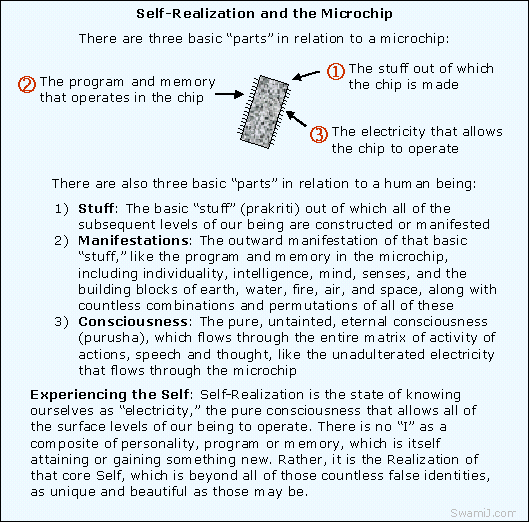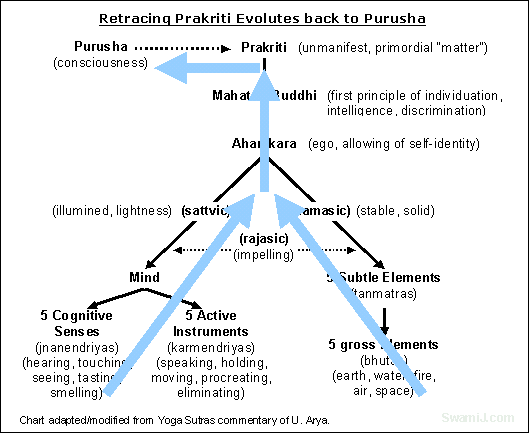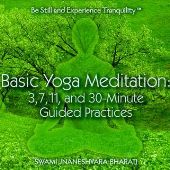|
|
||||||||||||||||
|
|
Online Courses from Swami Jnaneshvara and Abhyasa Ashram
Yoga Sutras 1.1-1.4:
|
|||||||||||||||
|
Yogash chitta vritti
nirodhah. |
Knowing what's left after setting aside the obstacles: There is a fundamental simplicity to the process of Yoga that is outlined in the Yoga Sutras. While the process might appear very complicated when reading the Yoga Sutras and many commentaries, the central theme is one of removing, transcending or setting aside the obstacles, veils or false identities. The many suggestions in the Yoga Sutras are the details or refinements of how to go about doing this. By being ever mindful of this core simplicity it is much easier to systematically progress on the path of Yoga.
The true Self shines through: Once the obstacles and false identities have been temporarily set aside, the true Self, which has been there all along, naturally comes shining through (1.3). The rest of the time, we are so entangled with our false identities that we literally do not see that this misidentification has happened (1.4). It is the reason that sometimes it is said that we are asleep, and that we need to awaken. That awakening to the Self is the meaning of Yoga.

 |
Like a mirror: Consciousness looks outward, through the intellect, through the mind, and then through the senses and body. It sees a reflection, like a mirror. It sees reality, a world, a self-identity, which it falsely thinks to be "me" or "mine." Through the forgetting power of avidya or ignorance (2.5), pure consciousness says, "I am this or that!" This is not all bad, for it gives the opportunity for the joy of awakening, through a journey called Yoga, returning to the wholeness that was never really divided in the first place. |
Yoga and Sankhya philosophies: The process of realization through Yoga rests on the discovery of pure consciousness (purusha) as separate from all the many false identities, which are considered to be evolutes of primal matter (prakriti). These principles of purusha and prakriti are part of the philosophical system known as Sankhya. Yoga and Sankhya are two of the six systems of Indian philosophy. See also these articles:
- Six Schools of Indian Philosophy
- Sankhya Yoga, Prakriti and Its Evolutes: Returning to Self-Realization
- Yoga Darshana and the Goal of Seeing Reality (Swami Rama discusses the foundations of Sankhya and the Yoga Sutras)
Yoga is samadhi: Both ancient and modern sages, including Vyasa, the most noteworthy commentator on the Yoga Sutra, flatly declare that Yoga is samadhi, the high state of perfected concentration or complete absorption of attention (3.3). Yoga means union, literally, to yoke, from the root yuj, which means to join or to integrate. It means to bring together the aspects of ourselves that were never divided in the first place. It means to attain direct experience of the core of that preexisting holistic being who we truly are at the deepest level, and that is attained through samadhi.
| See also the article: Bindu: Pinnacle of Yoga, Vedanta and Tantra |
|
The goal of Yoga is Yoga, period. (more) |
Yoga is not: Yoga is not merely physical fitness, stress management, medical treatment, or a means of manifesting money, although authentic Yoga is definitely beneficial to many aspects of life. The goal of Yoga is Yoga, period.
See also the article:
Modern Yoga versus Traditional Yoga
Introduction article: It is useful to read the Introduction to the Yoga Sutras page, which describes several approaches to exploring the Yoga Sutras pages of this website.
Swami Rama on the Yoga
Sutras
(The Video below is the 1st of 85 videos)
(Click
here for all 85
videos; about 13 hours - external site)
1.1
Now, after having done prior preparation through life and other practices,
the study and practice of Yoga begins.
(atha yoga anushasanam)
- atha = now, at this auspicious moment; implying the transition to this practice and pursuit, after prior preparation; implying a blessing at this moment of transition
- yoga = of yoga, union; literally, to yoke, from the root yuj, which means to join or to integrate; same as the absorption in samadhi
- anu = within, or following tradition; implies being subsequent to something else, in this case, the prior preparation
- shasanam = instruction, discipline, training, teaching, exposition, explanation; Shas implies the imparting of teaching that happens along with discipline
See also the article:
Now, Then, and Therefore
Yoga Discipline is Being Explained
(Swami Rama on Yoga Sutra 1.1)
Yoga comes after preparation: This introductory sutra suggests that after our many actions in life, and whatever preparatory practices we might have performed, now, we are finally ready to pursue the depths of self-exploration, the journey directly to the center of consciousness, Atman, or Self, our eternal and True identity.
Discipline and learning: To practice Yoga requires cultivating discipline and following a systematic method of learning (anushasanam). This has more to do with the quality or conviction in one's practices than it has to do with the quantity. This is described in greater detail in sutras 1.21 and 1.22.
Five states of mind: In describing this sutra, the sage Vyasa names five states of mind, of which the one-pointed (ekagra) (1.32) state of mind is the desired state of mind for the practice of Yoga. These five states of mind range from the severely troubled mind to the completely mastered mind. (These five are also described in the five states section of the Witnessing article.)
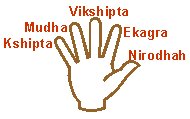 |
|
|
To position
the five states of mind on the fingers |
|
Know where you are: It is very useful to be aware of these stages, both in the moment, and as a general day-to-day level at which one is functioning. It reveals the depth of practice that one might be able to currently practice. Some aspect of yoga meditation applies to every human being, though we need to be mindful of which is most fitting and effective for a person with this or that state of mind.
Two of the states are desirable: Of the five states of mind (described below in more detail), the later two (one-pointed and mastered) are most desirable for the deeper practice of yoga meditation. For most people, our minds are usually in one of the first three states (disturbed, dull, or distracted). To deal with the troubled mind and the lethargic mind is progress, leading one to a merely distracted mind, from where one can more easily work on training the mind in one-pointedness.
Stabilize the mind in one-pointedness: By knowing this, we can deal with our minds so as to gradually stabilize the mind in the fourth state, the state of one-pointedness (Note that this use of the phrase fourth state is different from that used in relation to the fourth state of turiya). This is the state of mind which prepares us for the fifth state, in which there is mastery of mind. (The first two states might also be dominant or intense enough that they manifest as what psychologists call mental illness.)
|
Knowing where your mind is now |
1. Kshipta/disturbed: The ksihipta mind is disturbed, restless, troubled, wandering. This is the least desirable of the states of mind, in which the mind is troubled. It might be severely disturbed, moderately disturbed, or mildly disturbed. It might be worried, troubled, or chaotic. It is not merely the distracted mind (Vikshipta), but has the additional feature of a more intense, negative, emotional involvement.
2. Mudha/dull: The mudha mind is stupefied, dull, heavy, forgetful. With this state of mind, there is less of a running here and there of the thought process. It is a dull or sleepy state, somewhat like one experiences when depressed, though we are not here intending to mean only clinical depression. It is that heavy frame of mind we can get into, when we want to do nothing, to be lethargic, to be a couch potato.
The Mudha mind is barely beyond the Kshipta, disturbed mind, only in that the active disturbance has settled down, and the mind might be somewhat more easily trained from this place. Gradually the mind can be taught to be a little bit steady in a positive way, only occasionally distracted, which is the Vikshipta state. Then the mind can move on in training to the Ekagra and Nirodhah states.
3. Vikshipta/distracted: The Vikshipta mind is distracted, occasionally steady or focused. This is the state of mind often reported by students of meditation when they are wide awake and alert, neither noticeably disturbed nor dull and lethargic. Yet, in this state of mind, one's attention is easily drawn here and there. This is the monkey mind or noisy mind that people often talk about as disturbing meditation. The mind can concentrate for short periods of time, and is then distracted into some attraction or aversion. Then, the mind is brought back, only to again be distracted.
The Vikshipta mind in daily life can concentrate on this or that project, though it might wander here and there, or be pulled off course by some other person or outside influence, or by a rising memory. This Vikshipta mind is the stance one wants to attain through the foundation yoga practices, so that one can then pursue the one-pointedness of Ekagra, and the mastery that comes with the state of Nirodhah.
4. Ekagra/one-pointed: The Ekagra mind is one-pointed, focused, concentrated (Yoga Sutra 1.32). When the mind has attained the ability to be one-pointed, the real practice of Yoga meditation begins. It means that one can focus on tasks at hand in daily life, practicing karma yoga, the yoga of action, by being mindful of the mental process and consciously serving others. When the mind is one-pointed, other internal and external activities are simply not a distraction.
|
The ability to focus attention is a |
The person with a one-pointed mind just carries on with the matters at hand, undisturbed, unaffected, and uninvolved with those other stimuli. It is important to note that this is meant in a positive way, not the negative way of not attending to other people or other internal priorities. The one-pointed mind is fully present in the moment and able to attend to people, thoughts, and emotions at will.
The one-pointed mind is able to do the practices of concentration and meditation, leading one onward towards samadhi. This ability to focus attention is a primary skill that the student wants to develop for meditation and samadhi.
5. Nirodhah/mastered: The Nirodhah mind is highly mastered, controlled, regulated, restrained (Yoga Sutra 1.2). It is very difficult for one to capture the meaning of the Nirodhah state of mind by reading written descriptions. The real understanding of this state of mind comes only through practices of meditation and contemplation. When the word Nirodhah is translated as controlled, regulated, or restrained, it can easily be misunderstood to mean suppression of thoughts and emotions.
To suppress thoughts and emotions is not healthy and this is not what is meant here. Rather, it has to do with that natural process when the mind is one-pointed and becomes progressively more still as meditation deepens. It is not that the thought patterns are not there, or are suppressed, but that attention moves inward, or beyond the stream of inner impressions. In that deep stillness, there is a mastery over the process of mind. It is that mastery that is meant by Nirodhah.
In the second sutra of the Yoga Sutras (the sutra below), Yoga is defined as "Yogash Chitta Vritti Nirodhah," which is roughly translated as "Yoga is the control [nirodhah] of the thought patterns of the mind field." Thus, this Nirodhah state of mind is the goal and definition of Yoga. It is the doorway by which we go beyond the mind.
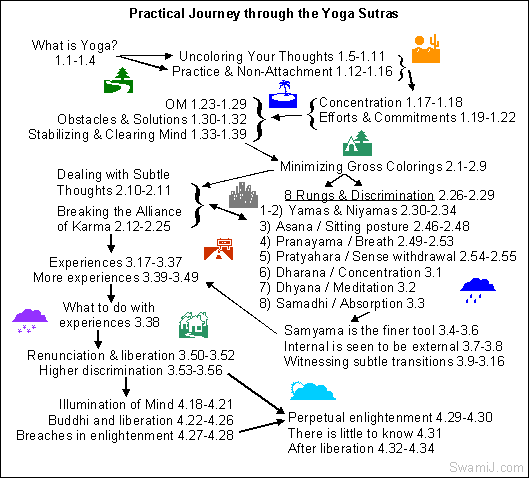
(You can click on the links in the above graphic)
1.2
Yoga is the control (nirodhah, regulation, channeling, mastery,
integration,
coordination, stilling, quieting, setting aside) of the modifications (gross and subtle thought patterns) of the
mind field.
(yogash chitta vritti nirodhah)
- yoga = of yoga, union; literally, to yoke, from the root yuj, which means to join; same as the absorption in samadhi
- chitta = of the consciousness of the mind-field
- vritti = operations, activities, fluctuations, modifications, changes, or various forms of the mind-field
- nirodhah = control, regulation, channeling, mastery, integration, coordination, understanding, stilling, quieting, setting aside of
Nirodhah suggests self-training: This single sentence is a most succinct definition of the science of Self-realization, or Yoga. The key to understanding is the word nirodhah, which defies translation or description. When translated poorly or misunderstood, it can sound like the suppression or repression of thoughts and emotions, which is definitely not what Yoga is about. Rather, it has to do with a process more like coordinating and setting aside what is not significant or not-self (2.5). It means finding the jewel of Truth that is underneath or behind all of the other activities in the mind-field. This comes through a self-training program dealing with the relationships, senses, body, breath, and mind. Ultimately, the meaning of nirodhah, and thus, of Yoga itself begins to emerge experientially through doing the practices.
Nirodhah is the most desired of five states of mind: The sage Vyasa names five states of mind, of which the nirodhah state of mind is the desired state of mind for the realization of the true Self. These five states of mind are described just above in the discussion of Sutra 1.1. It is extremely useful to be mindful of the five states of mind, so as to better understand their relationship to this most desired state of mind.
Uncoloring your thoughts: To find the jewel of the Self requires getting past the coloring of thought patterns (1.5), such as attachment, aversion, and fear (2.3). This involves witnessing your own inner process.
Practice and
non-attachment: Two principles remain at the core throughout this
self-training program: 1) Practices leading to stability and tranquility
and
Attitudes, efforts, and commitments: Five attitudes, efforts, and commitments are cultivated: faith in your direction, energy to go there, mindfulness and memory to stay there, and the ongoing commitment to seek the higher states of concentration and wisdom. (1.20)
Stabilizing and clearing the mind: Preparatory practices including meditation on attitudes towards people and ways to focus attention, are done to train the mind so that the subtler meditations can then be practiced. (1.33-1.39)
Reducing the gross colorings of mind: The more gross colorings of mind, dealing mostly with attractions, aversions, and fears are reduced through a process of training the senses, inner study, and surrender. (2.1-2.9)
Discrimination through eight rungs: Cultivating inner discrimination through the eight rungs of yoga (2.26-2.29), so as to systematically uncover that jewel of the Self. (1.3)
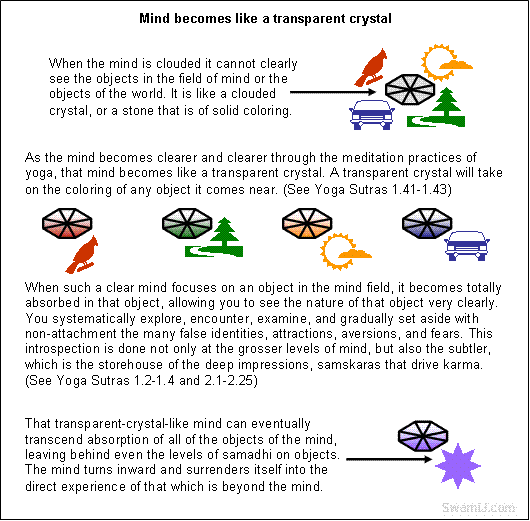
The "Seer" Beyond the
Mind
(Video on Yoga Sutras 1.2-1.3)
(More Videos by Swami
Jnaneshvara)
1.3
Then the Seer abides in Itself, resting in its own True Nature, which is
called Self-realization.
(tada drashtuh svarupe avasthanam)
- tada = then, at that time; at the time of concentration and meditation
- drashtuh = the seer's, of the soul, witness, Atman, Self; from the root drsh, which means to see (It is significant to note that Patanjali is not trying to define who is the seer, or the nature of that seer. This is left to be answered or resolved in direct experience.)
- svarupe = in its own nature, own form or essence; (sva = own; rupa = form)
- avasthanam = stability, settling, remaining, being in a state, resting, standing, lying, abiding; the root stha means to stand
Then the Self stands alone: As a result of having done the process of nirodhah, described in the last sutra, the true Self stands alone, unencumbered by our many false identities (described in the next sutra). This standing alone process is why the phrase Self-realization uses the word realization, rather than a word like attainment. The process is not one of attaining something we do not have, but rather is one of removing the clouds, so as to see the light that is already there.
![]()
The wave forgets the truth that it is ocean,
thinking itself
to be the grand shape, which it has temporarily taken.
For a while, it takes on the rupa (form) of wave.
Finally, it remembers its true rupa (form) of ocean.
The two coexist, though one is true, and the
other, though beautiful, is only relatively true.
So too, we humans forget our true nature,
but, through yoga, can remember.
Awareness remains unchanged: In deep meditation, you come to see that while the thought patterns shift here and there, ever changing their shape, the way that the waves on the ocean keep shifting, the awareness itself never changes. There is a constant, ever flowing, ever being awareness that simply is, that observes or witnesses. In meditation, this same truth is realized over and over, as layer after layer, level after level of mental process is revealed and seen to be like the deeper shifting of the ocean waves. The awareness itself remains unchanged, and will become clearer and clearer as the center of consciousness that stands alone, though part of all the levels it permeates.
The seer: The word drastuh means seer or witness. The word seer does not give you a theological or metaphysical description or definition of who you are. This is one of the beautiful qualities of Yoga and the Yoga Sutras. There is nothing in the word seer to believe or not believe. By saying that the seer rests in its true nature after transcending the many forms of thought patterns in the mind field (1.3), one can simply do the purifying practices and personally experience the results. In English translations, the word drashtuh is often given meanings such as Self, Soul, or Atman (such as in the translations above). This provides some clarity or speculation of the nature of this seer, but it is useful to remember that Patanjali is not actually telling you what is the nature of your true self, but that the seer will be experienced in itself, in its true nature, whatever or however that is ultimately experienced and described by each person.

Experiencing the seer in its own nature: Similarly, the word svarupe means in its own nature. Here also, Patanjali is not giving a definition of your true nature. Once again, there is nothing to believe or not believe. Through practice and non-attachment (1.12-1.16) and transcending the many mistaken identities (1.4, 2.5), you come to the direct experience of your own nature. Yet, most of us are curious and want to hear or read about the descriptions of this true nature, leading us to speak of, and to describe Self, Soul, or Atman, etc.. While we use, describe, and discuss these terms it is, again, most useful to keep in mind that Yoga actually refers to it simply as the seer, which is resting in its true nature, allowing direct experience to reveal what this is.
|
|
See also the article: Bindu: Pinnacle of Yoga, Vedanta and Tantra |

Purusha and Prakriti: The process of realization through Yoga rests on the discovery of pure consciousness (purusha) as separate from all the many false identities, which are considered to be evolutes of primal matter (prakriti). These principles of purusha and prakriti are part of the philosophical system known as Sankhya. Yoga and Sankhya are two of the six systems of Indian philosophy. See also these articles:
Discriminating between Purusha and Prakriti: The entire process of Yoga rests on discriminating between Purusha and the false identities of Prakriti. While this process of discrimination permeates the whole of the Yoga Sutras, the following three clusters of sutras will clarify the way discrimination relates to practices and realization:
- The 8 rungs and discrimination (2.26-2.29)
- Higher discrimination (3.53-3.56)
- Buddhi and liberation (4.22-4.26)
1.4
At other times, when one is not in Self-realization, the Seer appears to
take on the form of the modifications of the mind field, taking on the identity
of those thought patterns.
(vritti sarupyam itaratra)
- vritti = of the operations, activities, fluctuations, modifications, changes, or various forms (of the mind-field)
- sarupyam = similarity, assimilation, appearance of, identification of form or nature, conformity with the shape of; the root sa means with, and rupa means form
- itaratra = elsewhere, at other times, when not in that state of realization above
When we are not aware of our true nature: When activity of all levels of mind have been transcended (1.2), we experience pure consciousness (1.3). However, the rest of the time, mind flows towards the many sensory experiences we have, as well as towards the streams of memories and fantasies. The existence of the external world and the memories is not the problem. Rather, the pure consciousness mistakenly takes on the identity of those thought patterns. In this way, we incorrectly come to think that who we are is one and the same with these thoughts. The solution is to separate the seer and the seen (2.17), the experiencer and the object experienced, and this is the theme and practice of Yoga.
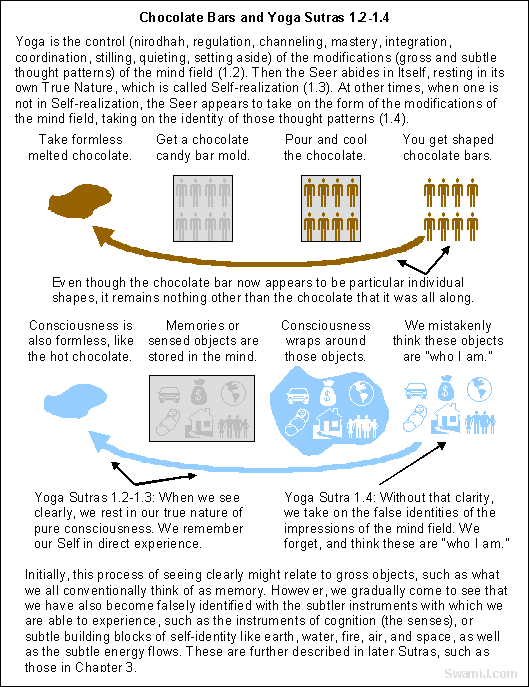
Consciousness wraps around mental objects: When a metal sculptor wants to make a mold, he might first make a plaster statue, then form the clay mold around that statue. Later, that clay becomes the mold for pouring the liquid metal. The process of the clay taking the form of the original plaster model is the meaning of the seer or Self appearing to take on the form of the thought pattern stored in the mind-field. When pure consciousness wraps itself around the mental object it encounters, it only appears to take on the identity of that object. It is a sort of mistaken identity that results.
Gold and clay: Gold is melted, reformed, and fashioned into many different ornaments. Yet, it remains gold. Clay is pushed and pulled and twisted, and shaped into many different bowls or other objects. Yet, it remains clay. However much consciousness shapes itself into the many objects stored in the mind field, that consciousness remains pure, standing alone. That consciousness, itself lacking any form, is described as having the nature of existence, consciousness, and bliss.
It is always a mental object: The object around which consciousness wraps itself is always an inner, mental object, even though there may be an external object being perceived through the senses (indriyas). If you see and smell your favorite food (or most offensive object), it is the memory of that experience, the mental object that is being triggered and brought to the surface. Even if you have never experienced this particular object before, it is presented through the eyes and nose (and other senses) to the mind field, as if on a movie screen, which the seer can then watch. The experience itself is between the inner witness and the presented object, and that presented object might come either through the senses or memory (or subtle realm, internal awareness). The significance of this is that we need to work with our inner awareness in relation to mental objects. In other words, we need to train our own mind and senses.
Five forms of mental objects: The five types of thought patterns that result from this false identity (of the Seer taking on false identities) are described in sutras 1.5-1.11. How to release consciousness from these few categories of mistaken identity is the process of enlightenment, and is the subject of the Yoga Sutras.
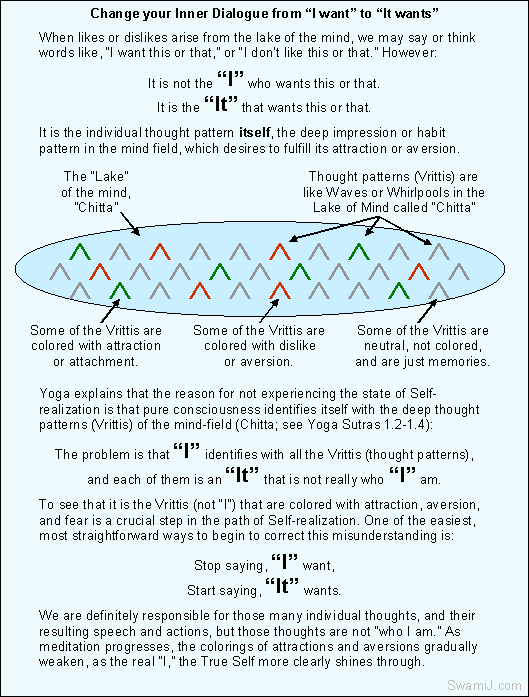
------- This site is devoted to
presenting the ancient Self-Realization path of
the Tradition of the Himalayan masters in simple, understandable and
beneficial ways, while not compromising quality or depth. The goal of
our sadhana or practices is the highest
Joy that comes from the Realization in direct experience of the
center of consciousness, the Self, the Atman or Purusha, which is
one and the same with the Absolute Reality.
This Self-Realization comes through Yoga meditation of the Yoga
Sutras, the contemplative insight of Advaita Vedanta, and the
intense devotion of Samaya Sri Vidya Tantra, the three of which
complement one another like fingers on a hand.
We employ the classical approaches of Raja, Jnana, Karma, and Bhakti
Yoga, as well as Hatha, Kriya, Kundalini, Laya, Mantra, Nada, Siddha,
and Tantra Yoga. Meditation, contemplation, mantra and prayer
finally converge into a unified force directed towards the final
stage, piercing the pearl of wisdom called bindu, leading to the
Absolute.

